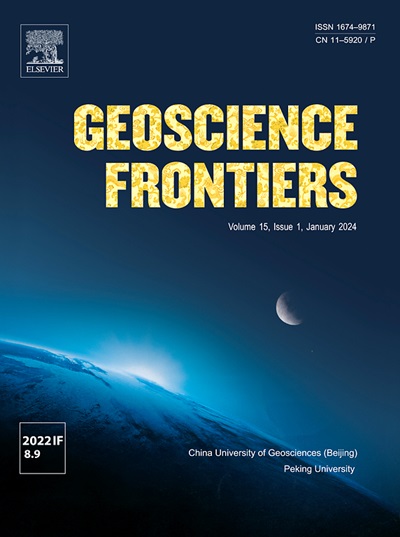原油中多环芳香族化合物作为塔里木二叠系大火成岩省活动的指标
IF 8.5
1区 地球科学
Q1 GEOSCIENCES, MULTIDISCIPLINARY
引用次数: 0
摘要
大火成岩省是地球科学研究的一个重要领域,它与古环境演化和生物多样性密切相关。塔里木二叠系大火成岩省(TLIP)为相关研究提供了理想的实验室。先前的报道表明,TLIP形成于~ 300-262 Ma。根据火成岩岩性和单次岩浆活动上限(<5 Ma),将该区划分为5个主要岩浆期。岩心测井、地震剖面、岩相观测和原位方解石U-Pb测年表明,TLIP岩浆活动导致辉绿岩侵入和热液上涌事件(~ 295.9-273 Ma)。结果表明,石油中多环芳香族化合物(PACs)是二叠纪TLIP岩浆侵入和热液活动的有力指标。现有辉绿岩侵入(EDI)样品显示出更高浓度的高分子量(HMW) PAC(≥5环PAC)和更高的燃烧衍生PAC比率。辉绿岩侵入物与PACs的分布耦合表明,HMW PACs主要来源于辉绿岩侵入物的环加成反应。菲(Phe)、联苯(Bp)和二苯并噻吩(DBT)系列化合物的转化表明油受到热液作用的改变。热液上涌过程携带的氢和硫促进了PACs的杂原子掺入。pac在lip形成过程中的环加成反应和杂原子掺入反应为评价其影响提供了新的视角。pac是lip的有效代理,也可能导致与lip相关的生物危机。本文章由计算机程序翻译,如有差异,请以英文原文为准。

Polycyclic aromatic compounds in crude oil as proxies for Permian Tarim large igneous province activities
Large igneous provinces (LIPs), a critical area in Earth science, are closely related to paleoenvironmental evolution and biodiversity. The Permian Tarim large igneous province (TLIP) provides an ideal laboratory for correlational research. Previous reports show that the TLIP formed ∼300–262 Ma. Based on igneous lithology and the upper limit of single magmatic activity (<5 Ma), the TLIP can be divided into five main magmatic episodes. Core logging, seismic sections, lithofacies observations, and in-situ calcite U-Pb dating indicate diabase intrusions and a hydrothermal upwelling event (∼295.9–273 Ma) resulted from TLIP magmatic activity. The results indicate that polycyclic aromatic compounds (PACs) in oil are powerful proxies of magmatic intrusion and hydrothermal activity in the Permian TLIP. The existing diabase intrusion (EDI) samples show a higher concentration of high-molecular-weight (HMW) PACs (≥5-ring PACs) and greater combustion-derived PAC ratios. The distribution coupling between the diabase intrusion and PACs indicates that the HMW PACs are mainly derived from the cycloaddition reactions by the pyrogenic source (i.e., diabase intrusion). The conversion of phenanthrene (Phe), biphenyl (Bp), and dibenzothiophene (DBT) series compounds indicates that the oil is altered by hydrothermal activity. The hydrogenium and sulfur carried by the hydrothermal upwelling process promote the heteroatom incorporation of PACs. The cycloaddition and heteroatom incorporation reactions of PACs during the formation of LIPs offer a new perspective for evaluating their impact. PACs serve as effective proxies for LIPs and may also contribute to biological crises associated with LIPs.
求助全文
通过发布文献求助,成功后即可免费获取论文全文。
去求助
来源期刊

Geoscience frontiers
Earth and Planetary Sciences-General Earth and Planetary Sciences
CiteScore
17.80
自引率
3.40%
发文量
147
审稿时长
35 days
期刊介绍:
Geoscience Frontiers (GSF) is the Journal of China University of Geosciences (Beijing) and Peking University. It publishes peer-reviewed research articles and reviews in interdisciplinary fields of Earth and Planetary Sciences. GSF covers various research areas including petrology and geochemistry, lithospheric architecture and mantle dynamics, global tectonics, economic geology and fuel exploration, geophysics, stratigraphy and paleontology, environmental and engineering geology, astrogeology, and the nexus of resources-energy-emissions-climate under Sustainable Development Goals. The journal aims to bridge innovative, provocative, and challenging concepts and models in these fields, providing insights on correlations and evolution.
 求助内容:
求助内容: 应助结果提醒方式:
应助结果提醒方式:


